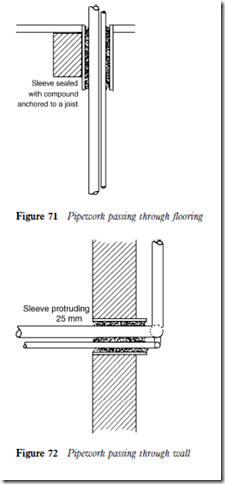Pipework routes
When condensing units or remote condensers are located above the level of a coldroom, it is possible that the pipework will pass through a wooden floor. The pipework will be subject to variations in temperature. Condensation can form on a suction line, and if this is insulated the insulation can become saturated.
This will encourage wet rot and fungal growth. In addition, the combination of a warm liquid line and wet materials will create an ideal environment for bacteria.
To overcome this problem a sleeve of metal or plastic, preferably the latter, should be inserted into the pipework aperture (Figure 71). The pipework is routed in the sleeve, which can then be sealed with a moisture and fire resistant compound. The sleeve is anchored firmly to a joist to avoid movement. Effective sealing of the sleeve prevents ingress of vermin. It also blocks off a supply of air, which would be undesirable if a fire started in the space below the floor. The sealing compound, being resilient, will prevent damage to pipework due to vibration.
The same principles should apply when pipework passes through a brick wall. The sleeve provided for an outside wall must protrude 25 mm to deny entry of rain water into the sleeve (see Figure 72).
Under no circumstances must electrical cables occupy the same sleeve as the refrigerant carrying pipework.
A condensing unit may be located on the ceiling of a small coldroom. It must be mounted on load bearing members; the weight of the unit will then be taken up by the supporting walls of the coldroom, thus preventing any sagging of the ceiling and subsequent breakdown of the insulation. An example is given in Figure 73.
